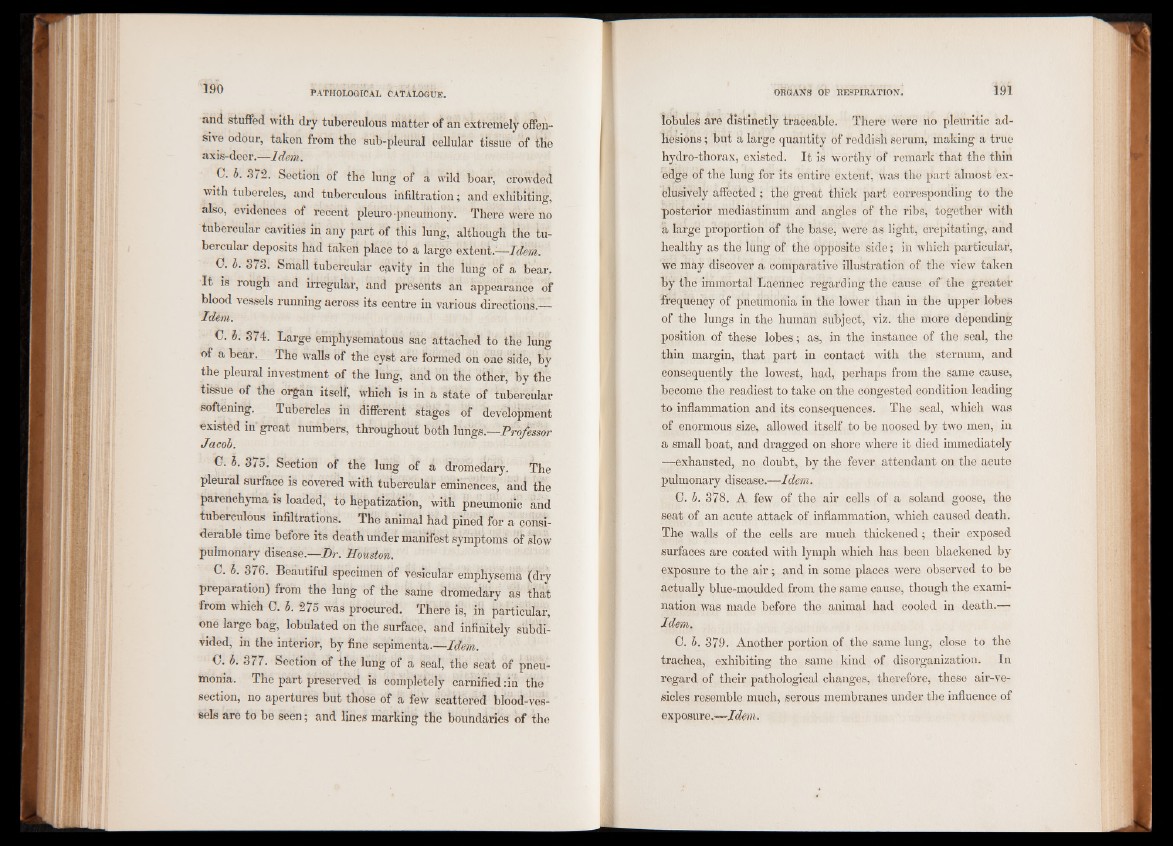
and stuffed with dry tuberculous matter of an extremely offensive
odour, taken from the sub-pleural cellular tissue of the
axis-deer.—Idem.
C. b. 372. Section of thé lung of a wild boar, crowded
with tubercles, and tuberculous infiltration ; and exhibiting,
also, evidences of recent pleuro-pneumony. There were no
tubercular cavities in any part of this lung, although the tubercular
deposits had taken place to a large extent.—Idem.
0. b. 373. Small tubercular cavity in the lung of a bear.
It is rough and irregular, and presents an appearance of
blood vessels running across its Idem. centre in various directions.—
C. b. 374. Large emphysematous sac attached to the lung
of a bear. The walls of the cyst are formed on óiïé side, by
the pleural investment of the lung, and on the other, by the
tissue of the organ itself, which is in a state of tubercular
softening. Tubercles in different stages of development
existed in great numbers, throughout both lungs.—Professor
Jacob.
€. b. 375. Section of the lung of a dromedary. The
pleural surface is covered with tubercular eminences, and the
parenchyma is loaded, to hepatization, with pneumonic and
tuberculous infiltrations. The animal had pined for a considerable
time before its death under manifest symptoms of slow
pulmonary disease.—Dr. Houston.
G. b. 376. Beautiful specimen of vesicular emphysema (dry
preparation) from the lung of the same dromedary as that
from which 0. b. 275 was procured. There is, in particular,
one large bag, lobulated on the surface, and infinitely subdivided,
in the interior, by fine sepimenta.—Idem.
€. b. 377. Section of the lung of a seal, the seat of pneumonia.
The part preserved is completely carnified :in the
section, no apertures but those of a few scattered blood-vessels
are to be seen ; and lines marking the boundaries of the
lobules are distinctly traceable. There were no pleuritic adhesions
; but a large quantity of reddish serum, making a true
hydro-thorax, existed. It is worthy of remark that the thin
edge of the lung for its entire extent, was the part almost exclusively
affected; the great thick part corresponding to the
posterior mediastinum and angles of the ribs, together with
a large proportion of the base, were as light, crepitating, and
healthy as the lung of the opposite side; in which particular,
we may discover a comparative illustration of the view taken
by the immortal Laennec regarding the cause of the greater
frequency of pneumonia in the lower than in the upper lobes
of the lungs in the human subject, viz. the more depending
position of these lobes; as, in the instance of the seal, the
thin margin, that part in contact with the sternum, and
consequently the lowest, had, perhaps from the same cause,
become the readiest to take on the congested condition leading
to inflammation and its consequences. The seal, which was
of enormous size, allowed itself to be noosed by two men, in
a small boat, and dragged on shore where it died immediately
—exhausted, no doubt, by the fever attendant on the acute
pulmonary disease.—Idem.
0. b. 378. A few of the air cells of a soland goose, the
seat of an acute attack of inflammation, which caused death.
The walls of the cells are much thickened; their exposed
surfaces are coated with lymph which has been blackened by
exposure to the air; and in some places were observed to be
actually blue-moulded from the same cause, though the examination
was made before the animal had cooled in death.—
Idem.
0. b. 379. Another portion of the same lung, close to the
trachea, exhibiting the same kind of disorganization. In
regard of their pathological changes, therefore, these air-vesicles
resemble much, serous membranes under the influence of
exposure.—Idem.